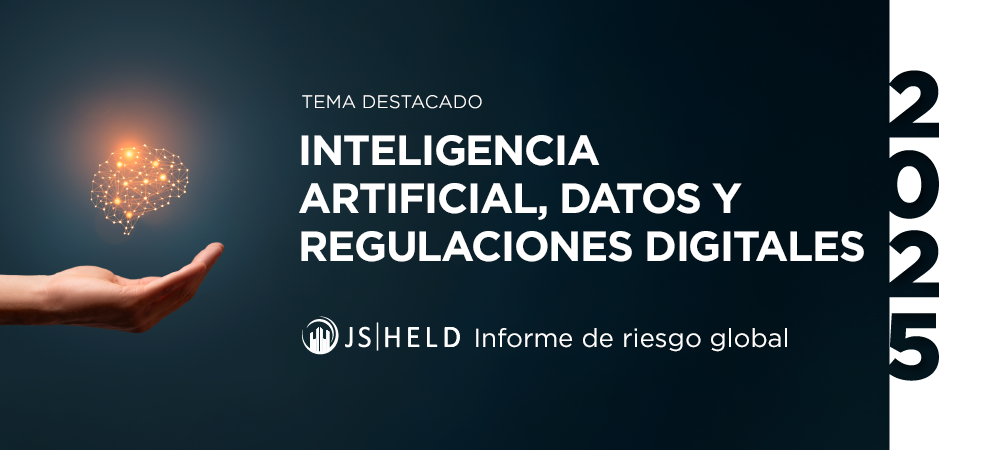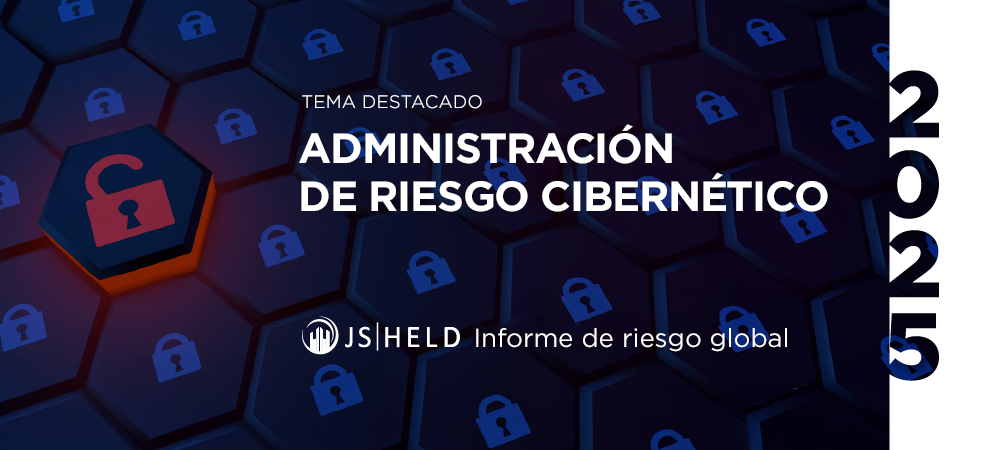El enfoque recomendado para las empresas en 2025 a nivel global es la adaptación, impulsada por transiciones políticas, avances tecnológicos, riesgos operativos en evolución, cambios regulatorios previstos y condiciones económicas cambiantes.
A través de nuestro trabajo como asesores de compañías de Fortune 100, estudios de abogados que integran la lista Global 200, las principales aseguradoras, instituciones financieras y agencias gubernamentales, y debido a que comprendemos algunas de las cuestiones de mayor impacto para las personas, además de los factores externos que se prevé que influyan en las organizaciones, seleccionamos cierta información para ayudar a los clientes a sortear los riesgos y capitalizar las oportunidades emergentes de este año.
Haga clic en los siguientes enlaces para ir a un tema destacado:
Al brindar mayor claridad sobre estos temas y sus riesgos y oportunidades relacionados, nos asociaremos con los clientes para que puedan anticiparse, adaptarse y avanzar en 2025. Si tiene alguna pregunta o desea seguir hablando acerca del informe, envíe un correo electrónico a [email protected].


La sostenibilidad sigue siendo un tema de gran interés en todo el mundo. Mientras que muchas jurisdicciones crean marcos adicionales para apoyar una mayor consideración de la sostenibilidad, otros países, sobre todo los EE.UU., se resisten o incluso retroceden. Al examinar las nuevas regulaciones medioambientales, sociales y de gobernanza (ESG) de diferentes partes del mundo, observamos que plantean un desafío a las empresas y organizaciones, ya que entran en vigor requisitos de cumplimiento contradictorios, algunos de los cuales pueden ser conflictivos.
Una incertidumbre significativa afectará a las empresas multinacionales que venden en el mercado de la UE, impulsada por la Directiva de Debida Diligencia de Sostenibilidad Corporativa (CS3D) de la UE. Adoptada en 2024, la CS3D requiere que las empresas de la UE y que no son de la UE lleven a cabo debida diligencia para identificar y evitar impactos adversos en el medioambiente y los derechos humanos dentro de su negocio y cadena de suministro. Los conflictos en requisitos de divulgación y elaboración de informes relacionados con el clima en distintas jurisdicciones continúan representando algunos de los desafíos más significativos a los que se enfrentan las compañías hoy en día.
Mientras tanto, en los EE. UU., el término "ESG" en sí mismo se tornó controvertido y provocó que muchos ahora hablen más ampliamente sobre la sostenibilidad, y analicen el término ESG como componente de informe de los esfuerzos debajo de un paraguas más amplio. Varios estados de los EE. UU. cuentan con criterios de ESG obligatorios, incluidos análisis de riesgo climático, para decisiones sobre inversiones en fondos de jubilación relacionados con el estado, mientras que otros estados se han opuesto a ese tipo de consideraciones de ESG. Aún así, las organizaciones deben contemplar las prácticas de sostenibilidad generales, ya que determinados permisos en muchas jurisdicciones no pueden obtenerse sin abordar el impacto ambiental. Con el inicio del segundo mandato de Trump, las directivas de justicia ambiental establecidas por el gobierno de Biden tienen los días contados, al igual que los subsidios y créditos fiscales otorgados por sostenibilidad.
Las empresas también pueden esperar un escrutinio judicial más minucioso en virtud de las últimas opiniones de la Corte Suprema, como el fallo Loper Bright, que recortó la autoridad de las agencias para definir el cumplimiento o incumplimiento reglamentario. El fallo incrementará la probabilidad de que surjan complicaciones para la sostenibilidad y otros programas reglamentarios de cumplimiento ambiental.
Desglose de la Directiva de Debida Diligencia de Sostenibilidad Corporativa (CS3D)
La CS3D se aplica a tres grupos principales:
Las compañías deben aplicar sus políticas de debida diligencia de ESG a los siguientes socios comerciales directos e indirectos en su cadena de suministro:
Las compañías deben exigir el cumplimiento empezando por la de mayor tamaño en 2027 y deben continuar, en el transcurso de los siguientes dos años, con las demás compañías de menor tamaño:
Reglas contra greenwashing and greenhushing a las que prestar atención


La importancia de la cadena de suministro global nunca fue más evidente desde que la pandemia por COVID-19 generó una escasez mundial de productos y empujó los precios y la inflación al alza.
Las interrupciones en la cadena de suministro se convirtieron en la norma, y pueden atribuirse a una amplia gama de eventos y condiciones actuales, que incluyen cambio climático, desastres naturales, ataques cibernéticos, fraude o inestabilidad geopolítica, como el conflicto en Medio Oriente o la guerra entre Rusia y Ucrania. Atrás quedaron los días en los que las compañías podían echar la culpa de los problemas de producción a los proveedores y no asumir ninguna responsabilidad. La mayor globalización a causa de la interconexión de las compañías incrementa la vulnerabilidad de estas últimas y de su cadena de suministro, que puede verse afectada por incidentes cibernéticos por distintas cuestiones, como la proliferación de Internet o la escasez de materiales básicos.
Además, ahora los clientes exigen saber de dónde provienen los productos de una compañía, cómo se obtienen, cómo se fabrican y si alguna parte del proceso tiene un efecto perjudicial sobre las personas o el medioambiente. Los gobiernos respondieron a esta situación estipulando nuevas reglas y reglamentaciones o exigiendo el cumplimiento de las existentes, con el fin de garantizar que la responsabilidad de la cadena de suministro sea una prioridad para compañías de todos los sectores. Esto es especialmente cierto en la Unión Europea, donde estados-miembros individuales promulgaron leyes y reglas de protección.
A medida que los consumidores, los gobiernos y las corporaciones reconozcan los efectos de los riesgos en la cadena de suministro, la transparencia y la debida diligencia se tornarán cada vez más cruciales para la estructura de cumplimiento interna de empresas globales. La promulgación y el mayor cumplimiento de leyes enfocadas en problemas de sostenibilidad incrementó las obligaciones de las compañías de examinar las fuentes y acciones de sus proveedores, y qué impacto tienen en toda la cadena de valor.


Si bien el sector de criptomonedas sigue siendo relativamente joven, su adopción por parte de diversos sectores económicos y la evolución de la tecnología en sí están en auge, además de la tokenización de los activos, los contratos inteligentes con tecnología de IA y las finanzas descentralizadas (DeFi) se están tornando cada vez más accesibles para los clientes. Sin embargo, junto con el auge de las expectativas y oportunidades en torno al sector de criptomonedas, también se incrementan las inquietudes respecto de la seguridad, la volatilidad y el escrutinio reglamentario.
Compañías de todos los sectores están analizando usar criptomonedas para obtener una ventaja. Incluso el sector de juegos ha ingresado en el espacio de criptomonedas, con servicios que ofrecen juegos con la modalidad "jugar para ganar". El anonimato es una característica fundamental, tanto para el riesgo como para el éxito de las criptomonedas. El concepto de conocimiento del cliente en plataformas centralizadas sigue siendo una exigencia, pero el anonimato atrae a algunos participantes hacia plataformas de finanzas descentralizadas (DeFi) que desean realizar transacciones entre pares sin un tercero. El anonimato también permite a los delincuentes utilizar monedas virtuales para llevar a cabo actividades ilícitas y ocultar sus ganancias. A los gobiernos también les preocupan la bancarrota de compañías de activos en criptomonedas y la falla de 2022 de la bolsa de criptomonedas FTX.
En los EE. UU., con la postura procriptomonedas del nuevo mandato de Trump, probablemente se observe un giro de las políticas previamente restrictivas que la Comisión de Bolsa y Valores había estado exigiendo. Muchos esperan una renovación de las reglamentaciones, con normas definidas con mayor claridad que fomenten la innovación y permitan a las compañías prosperar. La UE ha avanzado aún más en la regulación de las criptomonedas, con reglamentaciones para la transferencia de activos en criptomonedas, en aras de desalentar el blanqueo de capitales. La Ley de Mercados en Criptomonedas (MiCA) de la UE exige que las compañías que emitan criptomonedas o comercien con ellas obtengan una licencia. Desde 2026, la MiCA también exigirá que los proveedores de servicios de activos en criptomonedas recopilen información sobre el remitente y el beneficiario de transferencias. El RU exige a cualquier compañía que ofrezca criptomonedas que obtenga una autorización de la Autoridad de Conducta Financiera de la nación. China directamente ha prohibido el comercio y la minería de criptomonedas, mientras que Japón y Canadá exigen a las compañías de criptomonedas que se registren ante las entidades gubernamentales y cumplan las leyes contra el blanqueo de capitales. Dicho todo esto, existen numerosos riesgos e incertidumbres legales, ya que las criptomonedas se clasifican distinto según la entidad reglamentaria.


La inteligencia artificial (IA) ha sido promocionada como la respuesta a múltiples desafíos empresariales. Sin embargo, la IA, además del aprendizaje automático y de los modelos extensos de lenguaje (LLM), siguen estando cargados de desafíos técnicos y reglamentarios a medida que la tecnología evoluciona. Los actores que representan una amenaza utilizan la IA para crear videos, texto y audio falsos (deepfake); para elaborar correos electrónicos de phishing convincentes; para evadir las medidas de seguridad; y para automatizar actividades maliciosas, lo que genera inquietudes de seguridad nacionales e internacionales. Las compañías están desarrollando sus propios modelos de IA generativa (GenAI) para mejorar la eficiencia e incrementar sus resultados. No obstante, los algoritmos de GenAI demandan una enorme cantidad de datos para entrenar al sistema, lo que implica utilizar enormes conjuntos de datos de diversas fuentes y eso, a su vez, genera inquietudes de privacidad y derechos de autor respecto de la recopilación de datos.
En respuesta a ese problema, los gobiernos están proponiendo y/o promulgando nuevas leyes y reglamentaciones para evitar o mitigar los posibles daños ocasionados por el uso de IA. Por ejemplo, en Europa, existen nuevas reglamentaciones diseñadas para proteger los derechos fundamentales, que incluyen la privacidad de la información personal de los consumidores, así como otros problemas de justicia y ética. Si bien eso podría posicionar a la región en una posición desfavorable en comparación con el resto del mundo a causa de una mayor carga de elaboración de informes sobre las compañías, también aclara las obligaciones y reduce la carga de intentar armonizar diversas normas. A pesar de esas cuestiones, las compañías que busquen desarrollar un marco de IA deben darse cuenta de que una mayor cantidad de datos conlleva más riesgo, y deben implementar protolocos de riesgo adecuados para ayudar a garantizar la privacidad, la seguridad y la consideración de las políticas ambientales, sociales y de gobernanza (ESG) más amplias que cada organización ha puesto en marcha.
La Ley de Inteligencia Artificial de la UE clasifica la IA según su riesgo


Los incidentes cibernéticos, como el evento de 2024 que involucró a Change Healthcare, que puso en peligro la información personal de más de 100 millones de personas, destacan la naturaleza cambiante de las amenazas cibernéticas, que cada vez más se convierten en desafíos de gestión del riesgo impulsados por nuevas tecnologías revolucionarias, como la IA. Tales incidentes pueden suspender las operaciones, dar lugar a investigaciones regulatorias y ocasionar costos financieros significativos. A menudo, llevan a más reclamaciones de seguros y litigios de partes afectadas, e incluso abren la puerta para otros problemas, como el fraude. El caso de Change también subraya el constante aumento de la cantidad de ataques cibernéticos y filtraciones de datos, y de su gravedad.
En respuesta a estas tendencias, las entidades regulatorias y los legisladores, como la Comisión de Bolsa y Valores (SEC) de los EE. UU. y la Unión Europea, se han propuesto promulgar nuevas leyes y reglamentaciones que protejan a los consumidores, pacientes e inversores. Al tiempo que las amenazas continúan evolucionando y se redactan nuevas leyes, las organizaciones están implementando controles más rigurosos como parte de nuevos umbrales mínimos de seguridad cibernética estipulados por marcos de protección comunes, como el detallado por el Instituto Nacional de Normas y Tecnología (NIST) de los EE. UU.
Otra pregunta clave en torno a este tema: ¿conviene pagar un rescate o no? Si bien las compañías deben preguntar a su aseguradora si el pago estaría cubierto por su póliza, pagar un rescate podría, involuntariamente, poner en riesgo legal a una compañía, por ejemplo, al infringir políticas de sanciones de la Oficina de Control de Activos Extranjeros de los EE. UU. En definitiva, corresponde a las organizaciones actuar de forma proactiva para establecer un programa de respuesta ante incidentes y de seguridad de la información, contar con respaldo y protocolos adecuados implementados, y adquirir una comprensión cabal de qué cubre su seguro cibernético ante filtraciones de datos y otros ataques cibernéticos.
Una mirada más detallada de las reglamentaciones cibernéticas


Nos gustaría agradecer a nuestros expertos por sus contribuciones al informe de riesgo global de 2025 de J.S. Held.
Para obtener más información, comuníquese con: [email protected].
Esta comunicación puede contener declaraciones prospectivas. Estas declaraciones se basan en las expectativas actuales de J.S. Held y están sujetas a riesgos, incertidumbres y otros factores que podrían hacer que los resultados reales difieran sustancialmente de los expresados o insinuados en estas declaraciones prospectivas. Las declaraciones prospectivas solo son válidas en la fecha en que se hacen, y no asumimos ninguna obligación de actualizar o revisar ninguna declaración prospectiva, ya sea como resultado de nueva información, acontecimientos futuros u otros motivos. Este material es solo para fines informativos y se proporciona "tal y como está" sin ninguna garantía y J.S. Held no asume ninguna responsabilidad por errores, omisiones o cualquier medida tomada en función de este material.
En el informe de riesgo global de J.S. Held, combinamos nuestra experiencia técnica, científica, financiera y estratégica para brindar información sobre los temas con mayor influencia de 2024...
Analizamos los desafíos y oportunidades que surgen de los aranceles impuestos por Estados Unidos, y ofrecemos perspectivas para que las empresas reduzcan riesgos y mantengan su competitividad...